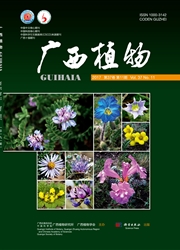

 中文摘要:
中文摘要:
棕榈酰化修饰是一种最普遍且唯一可逆的翻译后脂质修饰方式,赋予蛋白质多样化的生理功能。DHHC( Asp-His-His-Cys)蛋白家族是一类与棕榈酰化修饰相关的蛋白,多数DHHC蛋白家族成员具有蛋白质酰基转移酶( protein S-acyltransferase,PAT)活性。该研究以鹅掌楸叶芽为材料,采用RT-PCR和RACE技术,克隆获得了3个鹅掌楸DHHC蛋白家族基因cDNA全长,命名为LcPAT7、LcPAT22、LcPAT23。序列分析结果表明:LcPAT7、LcPAT22、LcPAT23基因全长分别为1933、2592、2217 bp,各包含1332、1839、1662 bp的开放阅读框( Open Reading Frame,ORF),编码433、612、533个氨基酸,预测蛋白分子量分别为40.04、67.3、60.57 kDa,理论等电点为9.15、9.03、7.29。3个基因编码的蛋白均有4个跨膜区,并且都在跨膜域( transmembrane domain, TM) TM2和 TM3之间存在一个 DHHC 蛋白家族典型的 DHHC-CRD 结构域。同源性分析表明:鹅掌楸LcPAT7、LcPAT22、LcPAT23编码的氨基酸序列与其他植物中预测的PAT具有较高的相似性。利用荧光定量PCR技术检测3个基因在鹅掌楸不同组织中的表达特性,发现3个基因在不同组织中均有表达,但表达量具有明显区别。同一家族基因表达模式的变化表明其功能非冗余。该研究结果将为鹅掌楸生长发育与形态建成,以及逆境响应信号传导等相关基因的调控研究提供了参考。
 英文摘要:
英文摘要:
Protein S-acylation is a common and unique reversible way in posttranslational lipid modification, thus confers diverse physiological functions on target proteins, such as DHHC ( Asp-His-His-Cys) protein family. There was evidence that the DHHC domain was directly involved in the palmitoyl transfer reaction. In this paper, we reports gene cloning and expression analysis of DHHC protein family genes in Liriodendron chinense. Three full-length cDNA of DH-HC gene were cloned from Liriodendron leaf buds using the rapid amplification of cDNA ends ( RACE) strategy, named LcPAT7, LcPAT22 and LcPAT23 respectively. The full-length cDNAs of LcPAT7, LcPAT22 and LcPAT23 were 1 933 bp, 2 592 bp and 2 217 bp, and contain 1 332 bp, 1 839 bp and 1 662 bp ORF, encoding 433, 612 and 533 amino acids, respectively. The predicted molecular weights of the proteins encoded by LcPAT7, LcPAT22 and LcPAT23 were 40.04,67.3 and 60.57 kDa, respectively. The predicted isoelectric points are 9.15, 9.03 and 7.29, respectively. All the three proteins contained four putative transmembrane ( TM) domain structures, and contained a typically DHHC-CRD domain between TM2 and TM3 as most known DHHC protein. Homology analysis showed that the three genes showed high simi-larity with predicted PAT (protein S-acyltransferase) of other plants. Tissue expression profile by Real-time PCR showed that all the three genes were expressed in various tissues, although the expression levels varied significantly in different tissues. Changes in gene expression patterns in the same gene family indicated their functionally non-redundancy. These results above will provide clues for exploring the underlying mechanism of gene regulation on growth, development, mor-phogenesis and signal transduction of stress response in L. chinense.
 同期刊论文项目
同期刊论文项目
 同项目期刊论文
同项目期刊论文
 Relationship between parental genetic distance andoffspring’s heterosis for early growth traits in L
Relationship between parental genetic distance andoffspring’s heterosis for early growth traits in L 期刊信息
期刊信息
